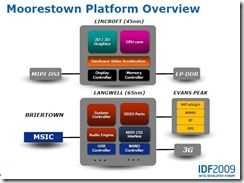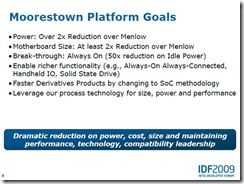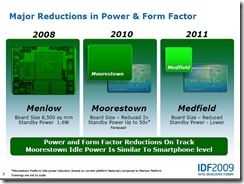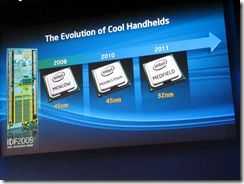 I took MIDMoves to the Intel Developer Forum in San Francisco last week with a focus on the three M’s of MIDs, Moblin and Moorestown. IDF is the highlight of my mobile computing year and I was hoping to see Moorestown MIDs being demonstrated, the launch of Moblin 2.0 and a bunch of new products. As it happens, we got the expected Moblin 2.0 launch but didn’t see much in terms of hardware. We did get a few surprises though and as usual, in-depth information that helps us predict what is going to happen in 2010 and 2011. Here’s a summary of the Intel Developer Forum 2009 for a mobile computing perspective.
I took MIDMoves to the Intel Developer Forum in San Francisco last week with a focus on the three M’s of MIDs, Moblin and Moorestown. IDF is the highlight of my mobile computing year and I was hoping to see Moorestown MIDs being demonstrated, the launch of Moblin 2.0 and a bunch of new products. As it happens, we got the expected Moblin 2.0 launch but didn’t see much in terms of hardware. We did get a few surprises though and as usual, in-depth information that helps us predict what is going to happen in 2010 and 2011. Here’s a summary of the Intel Developer Forum 2009 for a mobile computing perspective.
Moorestown.
Although we didn’t get to see any new Moorestown prototypes we got a good set of detail on the hardware, a demonstration of a previously seen device that is now in working order with ‘2nd-cut’ silicon along with an indication of the launch dates.
One of the key pieces of information is hidden in one of the presentations [pdf] and it mentions, in one line, that we should expect a 2x reduction in power utilization over Menlow. Although those 50x idle reduction figures sound nice, this 2x power reduction indication is much more realistic. Because of the new power-gating process, even CPU-intensive operations like web browsing will return better battery life as parts of the system are powered-down.
With the reduction in board size (we’re down to credit-card size with Moorestown and should expect to see 50% reductions with Medfield in 2011) and the power utilisation reductions, expect devices that are half the volume of tablet-style MIDS like the Viliv S5; about the size of a large smartphone. Clamshell and slider devices won’t benefit so much due to the space needed for the keyboard but Moorestown will certainly open up more design opportunities here. For a more detailed article on Moorestown and the core features, see this article.
As for launch dates, Intel told us on more than one occasion that voice-enabled devices, ‘media phones’, may take longer to come to market than other devices after the launch of the silicon. Expect voice-capable media phones in late 2010 with the launch of the silicon in the first half of the year.
Moblin.
A little later than expected is the final release of the Moblin 2.0 ‘Project’ code. Dell and Canonical presented the availability of the Dell Mini 10v Moblin Remix Developers Edition (based on 2.0beta) and Linpus told us that their Moblin 2.0 releases (two of them) will be available in a week or so. [Linpus Lite video overview here] Novell are also close behind and you may see it rolled up into the next OpenSUSE build.
Moblin 2.1 for netbooks will be following-up in Q4 with general improvements [announcement] although it might also include some of the internal work and drivers needed for Moblin 2.1 for handhelds. For Menlow-based device owners, this is one to test out as soon as it’s available.
 Moblin 2.1 for handhelds will be released with Moorestown in the first half of 2010. Don’t expect anything before April though and of course, devices based on Moorestown will still be some way behind. Fingers crossed that it supports the Menlow platform although the ‘power gating’ feature that brings idle standby savings definitely won’t work. I’ve uploaded a two-part video from a private demonstration session where you hear Intel answer questions and then see a demo of the UI. There’s also a demo video of a working Moorestown platform showing a similar touch-driven user interface.
Moblin 2.1 for handhelds will be released with Moorestown in the first half of 2010. Don’t expect anything before April though and of course, devices based on Moorestown will still be some way behind. Fingers crossed that it supports the Menlow platform although the ‘power gating’ feature that brings idle standby savings definitely won’t work. I’ve uploaded a two-part video from a private demonstration session where you hear Intel answer questions and then see a demo of the UI. There’s also a demo video of a working Moorestown platform showing a similar touch-driven user interface.
Sidenote: I spoke to Novell about Moblin 2.0. They already have some touch drivers included in their release. This could be interesting for Gigabyte Touchbook owners. Check out the next release of OpenSUSE later in the year.
Applications ecosystem.
One of the most significant of the announcements at IDF was the news about the Intel Atom Developer Program, an aplications-store architecture that enables developers to submit programs and components into a marketing and sales application (an ‘App-store’) that can be included on Moblin and Windows netbooks. Of course, I’m very pleased about this!
Timescales for the app-store are estimated to be into 2010 but it’s a smart move by Intel. With 40+million netbooks out there already and a new wave of Moblin and Pinetrail netbooks coming, developers need to be paying attention to this. I’ve written more details about the IADP in this article. Also note that a competition has already launched. Create an app and win a netbook!
In the meantime, the Moblin teams have created a ‘garage’ of application that simplifies the process of searching and installing end-user software. The garage requires client software to be installed on a Moblin 2.0 device (this is sounding like a re-brand of moblin.cnr.com to me!) Details on the garage are available here.
Medfield
Timescales shown in presentations were for ‘2011’ but its safe to project at least 12 months beyond the launch of Moorestown in mid 2010. Devices probably won’t be reaching customers until 2012. Medfield is a single chip solution created using a 32nm process.
Note that we probably won’t see a repeat of the huge idle-state power improvements that are being achieved with Moorestown’s ‘power gating’ but based on the process technology being used (single-chip, 32nm) we should see significant power savings across the board. Maybe we’ll see enough power savings improvement for the marketing teams to be talking about the 1-watt PC!
Next page…
Pages: 1 2















M&M&M's. What #IDF09 meant for mobility. (IDF summary of mobility related information) http://cli.gs/8AquN
M&M&Ms What IDF09 meant for Mobility. http://bit.ly/2vW2G
My old Zaurus C1000 consume less than 1 watt, including processors but also screen, flash memory, etc.
So for 1-watt PC, I think that ARM processors are definitively more interesting than Intel ones !
The matter is where you are going not where you come from. ARM processors are going to take longer to get to Intel power levels than intel to get ARM comsumption levels.
Is that really true, though? We’ll probably see quad-core Cortex A9 chips by the end of next year. The Cortex A family already have roughly equivalent instructions-per-second-per-clock to the Atom family.
Being limited to the ARM/Linux software library instead of the X86/Windows one is the real issue, I think.
As much I like ARM, they don’t run Windows.
They have a future in MIDs platform only if Linux distributions like Moblin becomes popular.
If this do not happen, they could consume 0.0001 watt , but still they would not sell units.
Good post, I look forward to the reduced power consumption that would be great if the moorestown platform was using half the power, but I don’t see that happening unless you only use the device infrequently and it’s on standby most of the time because of your individual usage behaviors.